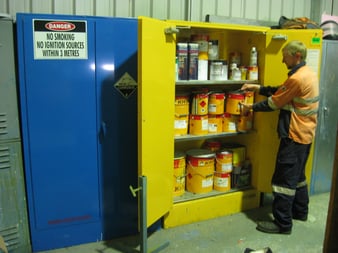Is your business carrying Class 3 Flammable Liquids? These hazardous chemicals are a common sight in workplaces across the country, but they require careful management and storage to control the risks that they pose. In this blog, we’ll explain how you can protect your people and your property by listing 8 ways flammable liquids cabinets increase safety and reduce compliance risk.
IMPORTANT: When selecting an indoor flammable liquids storage cabinet, you should make sure it’s manufactured to Australia Standard AS1940:2017 – The storage and handling of flammable and combustible liquids. Only compliant cabinets are designed and constructed to be an effective risk control measure for the safe storage of flammable liquids.
1. Risk Management
Using safety cabinets that have been purpose built for Class 3 Flammable Liquids is an accepted isolation control.
Flammable cabinets will help you comply with Sections 32-38 and Section 351 of the WHS Regulations, which is detailed below:
351 Management of risks to health or safety
- A person conducting a business or undertaking must manage, in accordance with Part 3.1, risks to health and safety associated with using, handling, generating or storing a hazardous chemical at a workplace.
Businesses should be particularly aware of the necessity to isolate chemicals from other people on the job site. This safety measure is to reduce the risk of human harm through asphyxiation, chemical burns, eye irritation or other harmful health effects that may be caused by exposure to flammable liquids.
 Your flammable cabinet is an isolation control which helps minimise health and safety risks.
Your flammable cabinet is an isolation control which helps minimise health and safety risks.
2. Workplace Facilities
Using flammable liquids cabinets helps create a work environment where your staff and contractors can safely carry out their work.
As stated in Section 41 of the WHS Regulations:
41 Duty to provide and maintain adequate and accessible facilities
(2) The person conducting a business or undertaking at a workplace must ensure, so far as is reasonably practicable, that the facilities provided under subregulation (1) are maintained so as to be:
(a) in good working order; and
(b) clean, safe and accessible.
A compliant cabinet contains flammable vapours and harmful fumes. But more importantly, it encourages good housekeeping practices — minimising the potential for chemical containers to be left lying around the job site or sitting open on bench tops.
3. Emergency Planning
Every workplace in Australia needs an emergency plan, especially if your business carries Class 3 Flammable Liquids.
Section 43 of the WHS Regulations explains:
Division 4 Emergency plans
43 Duty to prepare, maintain and implement emergency plan
(1) A person conducting a business or undertaking at a workplace must ensure that an emergency plan is prepared for the workplace, that provides for the following:(a) emergency procedures, including:
(i) an effective response to an emergency; and
(ii) evacuation procedures; and
(iii) notifying emergency service organisations at the earliest opportunity; and
(iv) medical treatment and assistance; and
(v) effective communication between the person authorised by the person conducting the business or undertaking to coordinate the emergency response and all persons at the workplace;
Using a safety cabinet assists the emergency management process in the following ways:
- Flammable liquids are consolidated into clearly marked areas.
- Safety cabinets and aggregate quantities can be marked on site plans and evacuation maps.
- Evacuation routes can be planned and directed away from flammable liquids stores.
- Cabinet construction materials means they can withstand temperatures of up to 850°C — giving building occupants and workers up to 10 minutes to engage fire protection systems and evacuate the area.
4. Exposure Standards
Flammable liquids emit harmful fumes, vapours, mists and other emissions. And if allowed to accumulate in the breathing zones of workers, these harmful emissions can cause a wide range of adverse health effects — from dizziness and nausea to asthma, cancer or even death.
It is a legal requirement of the WHS Regulations to ensure that chemical concentration levels (in the breathing zones of workers) remain within the workplace exposure standards issued by Safe Work Australia.
Section 49 of the WHS Regulations explains:
Division 7 Managing risks from airborne contaminants
49 Ensuring exposure standards for substances and mixtures not exceeded
A person conducting a business or undertaking at a workplace must ensure that no person at the workplace is exposed to a substance or mixture in an airborne concentration that exceeds the exposure standard for the substance or mixture.
To minimise these serious health risks, indoor flammable liquids cabinet are specifically designed to contain vapours and fumes within the cabinet. This prevents the emissions from escaping the storage area and contaminating other work zones within your organisation.
5. Hazardous Atmospheres
Your compliant flammable cabinet is constructed to minimise the likelihood of flammable vapours or liquids escaping the storage area and causing a hazardous atmosphere in your workplace.
Some examples of a hazardous atmosphere include:
- Oxygen deficient environments — open containers of flammable liquids in a confined space or low-lying areas can displace the oxygen content of the air.
- Oxygen rich environment — presence of oxidisers will increase oxygen concentrations as well as the risk of fires and explosions.
- Explosive environment — when chemical concentration (and temperatures) increase, flammable liquids can reach their explosive and auto-ignition range. This is greatly reduced as flammable liquids cabinets restrict the quantities able to be stored in one place.
- Ignition sources — cabinets place a barrier between the chemicals and ignition sources like heat, sparks, flames, and static discharge.
Flammable liquids cabinets must be built with a dual-skinned steel construction for superior protection and safety. Compliant cabinets are constructed with close-fitting doors and feature a liquid-tight spill containment sump to assist with the management of chemical spills and leaks.
6. Safety Signage
The WHS Regulations explain that warning signs must be clearly visible. Signage must also be placed as close to the hazard as possible.
The regulation states:
353 Safety signs
(1) This regulation applies if a safety sign is required to control an identified risk in relation to using, handling, generating or storing hazardous chemicals at a workplace.(2) A person conducting a business or undertaking at the workplace must display a safety sign at the workplace to:
(a) warn of a particular hazard associated with the hazardous chemicals; or
(b) state the responsibilities of a particular person in relation to the hazardous chemicals.
Flammable liquids cabinets come complete with fitted with compliant warning signs. It is a legal requirement that organisations continue to maintain the safety signs and keep them clearly visible to all staff members
7. Chemical Stability
Your cabinet can also help maintain the chemical stability of your flammable liquids. Because compliant cabinets are dual-skinned and located indoors, the chemicals inside the cabinet remain at a relatively even temperature – so instability does not occur. The regulations also require you to prevent the flammable liquids from increasing the risks associated with other chemicals or substances stored at the job site. Flammable cabinets therefore act as an aid in chemical segregation of incompatible substances.
 Compliant flammable cabinets can help you comply with regulations by ensuring the stability of stored chemicals.
Compliant flammable cabinets can help you comply with regulations by ensuring the stability of stored chemicals.
You can meet your compliance obligations as stated in WHS Regulations by storing your flammables in a compliant cabinet:
354 Identification of risk of physical or chemical reaction
(1) A person conducting a business or undertaking at a workplace must identify any risk of a physical or chemical reaction in relation to a hazardous chemical used, handled, generated or stored at a workplace.
8. Spill Management
If there is any risk of an uncontrolled release of hazardous chemicals, your workplace must have spill management and containment facilities in place.
This is a legal requirement under Section 357 of the WHS Regulations.
Subdivision 2 Spills and damage
357 Containing and managing spills
- A person conducting a business or undertaking at a workplace must ensure, so far as is reasonably practicable, that where there is a risk from a spill or leak of a hazardous chemical in a solid or liquid form, provision is made in each part of the workplace where the hazardous chemical is used, handled, generated or stored for a spill containment system that contains within the workplace any part of the hazardous chemical that spills or leaks, and any resulting effluent.
- Cracked, damaged, or broken containers.
- Open containers that get knocked over.
- Containers that are dropped, in a tall stack that collapses, or impacted.
Flammable liquids cabinets are 100% liquid-tight and can therefore safely contain chemical leaks. The cabinet prevents the release of harmful liquids, vapours, and effluent into work areas or the environment.
Do You Know How To Reduce Your Compliance Risk?
Now that you’ve read the 8 ways that flammable liquids cabinets reduce safety and compliance, we invite you to download our helpful and easy-to-read eBook. Essential Considerations When Storing Flammable Liquids Indoors is STOREMASTA’s go-to guide that can help you effectively reduce your chemical compliance risk — and improve your overall safety rating. Access our free eBook today to learn more about chemical compliance.
Joining the team as a Dangerous Goods Storage Consultant, Melissa Hampton became Storemasta's Marketing Manager in late 2021. With extensive knowledge and experience in chemical compliance, Melissa is responsible for leading the Marketing team and helping shape their marketing strategy. In her spare time, you can find Melissa hiking, swimming and enjoying the great outdoors in beautiful north-west Tasmania.
